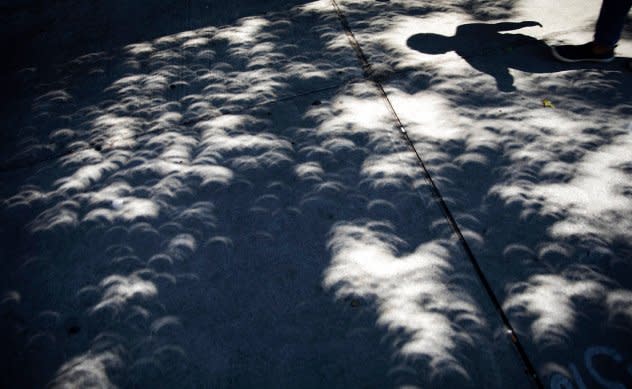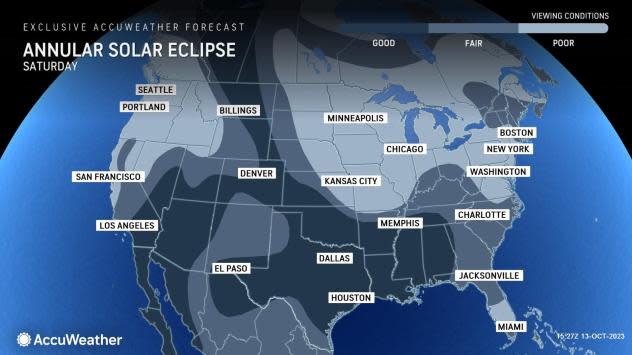How to see Saturday's solar eclipse if you don't have eclipse glasses
The cosmos will align Saturday to create a solar eclipse that can be viewed from nearly all of North America and South America, the first of two solar eclipses that will be visible in the United States in a span of 177 days.
The primary viewing zone for the annular solar eclipse in the U.S. will be across a narrow corridor from southern Oregon to southern Texas where the moon will cover the sun's center in a phenomenon nicknamed a "ring of fire." However, the remainder of the country will be able to witness a partial solar eclipse, for some, the first since 2017.
Eye protection is paramount, as looking at the sun without a solar filter or eclipse glasses can cause serious, potentially long-lasting, eye damage.
 |
A girl looks through special glasses during a partial solar eclipse in Bucharest, Romania, Tuesday, Oct. 25, 2022. (AP Photo/Vadim Ghirda) |
With time running out to order a pair of specially designed eclipse glasses, people may need to rely on other methods to view a solar eclipse -- some of which require only a few items commonly found around the house.
One of the easiest eclipse experiments involves a pasta strainer that has plenty of small, circular holes.
As the moon blocks out part of the sun, hold the strainer out so that sunlight shines through the holes of the colander. Instead of circles of light appearing in the shadow, the light will be in the shape of crescents.
 |
A member of the White House kitchen staff brings out a colander to view the solar eclipse at the White House in Washington, Monday, Aug. 21, 2017. (AP Photo/Andrew Harnik) |
A similar effect can be replicated by poking holes in a sheet of paper or by using any item that has small circular holes.
A pinhole projector is a simple project that is easy to make with kids, and all it takes are a few items that most people already have in their homes. During a solar eclipse, a projector can show how much of the sun is being blocked out by the moon.
An empty cereal box, scissors, a piece of aluminum foil, tape and a pin are all that will be needed to make a homemade pinhole projector. Watch the video below to learn how to assemble the projector:
A pinhole projector can also be made with a sheet of paper by following these step-by-step instructions from NASA.
Fall foliage is in full swing across the northern tier of the U.S., but on Saturday, instead of looking up at the colorful leaves, eclipse onlookers should glance down at the shadows cast by trees.
As the moon blocks out part of the sun, light that shines through the trees' foliage will create crescent shapes. The more of the sun that is blocked out, the more prominent the crescents will be.
 |
Shadows from a near total solar eclipse are projected on a sidewalk as a pedestrian passes in midtown Atlanta, Monday, Aug. 21, 2017. (AP Photo/David Goldman) |
Some people may miss out on this phenomenon during the solar eclipse on April 8, 2024, as some trees may not have leaves yet following the winter months.
If cloudy conditions prevail Saturday, people can still enjoy the eclipse online.
NASA will broadcast the event live on its YouTube channel with views of the eclipse across the country and commentary from experts.
Millions of people used eclipse glasses in 2017 to view the Great American Eclipse, which was visible from coast to coast.
Anyone who safely stowed away their glasses should be able to reuse them this weekend, as well as next April, as long as they have "ISO 12312-2" printed on them.
This ISO label is the international standard for eclipse glasses and solar filters. According to the American Astronomical Society (AAS), any solar filter that has the proper label can be reused indefinitely as long as they are not scratched.
"Some glasses/viewers are printed with warnings stating that you shouldn't look through them for more than 3 minutes at a time and that you should discard them if they are more than 3 years old. Such warnings are outdated and do not apply to eclipse viewers compliant with the ISO 12312-2 standard and in excellent condition," the AAS explained on its website.
 |
A woman looks through a special glass during a solar eclipse, partially seen in Montevideo, Uruguay, Tuesday, July 2, 2019. A solar eclipse occurs when the moon passes between the Earth and the sun and scores a bull’s-eye by completely blocking out the sunlight. (AP Photo/Matilde Campodonico) |
Welding glasses that are shade 14 can also be used to look at the sun safely.
"A solar eclipse is one of nature's grandest spectacles," the AAS said. "By following these simple rules, you can safely enjoy the view and be rewarded with memories to last a lifetime."
 |
The weather could prove to be problematic for viewing Saturday's eclipse across roughly half of the United States. Since the eclipse happens over the course of several hours, only a few breaks in the clouds are needed to catch a glimpse of the event.
Cloudy conditions are in the forecast across most of the West Coast, as well as large sections of the Northeast, Midwest and northern Plains. Enough breaks in the clouds are likely to see at least part of the eclipse elsewhere in the eastern U.S., as well as across the Great Basin and Rocky Mountains.
The best viewing conditions are expected over the Gulf Coast states and most of Texas, as well as over most of the Southwest. This includes some of the most-populated areas where the "ring of fire" will be visible.
Want next-level safety, ad-free? Unlock advanced, hyperlocal severe weather alerts when you subscribe to Premium+ on the AccuWeather app. AccuWeather Alerts™ are prompted by our expert meteorologists who monitor and analyze dangerous weather risks 24/7 to keep you and your family safer.






